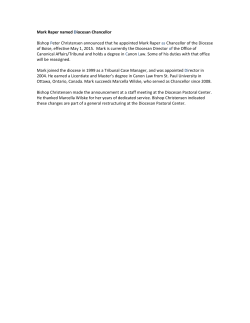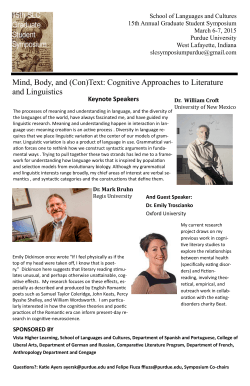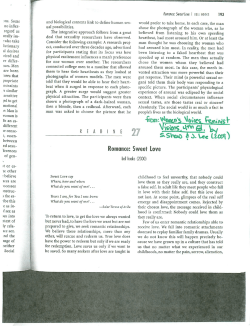
Journal for the S tud y of r omantic iS mS Journal for the S tud y of r
03 Journal for the Study of romanticiSmS JOURNAL FOR THE STUDY OF ROMANTICISMS 03 Editors Robert W. Rix (University of Copenhagen), Lis Møller (Aarhus University), Karina Lykke Grand (Aarhus University), Anna Lena Sandberg (University of Copenhagen), Cian Duffy (University of Copenhagen and St. Mary’s University College, Twickenham, London) Nordic Co-Editor (third issue) Elisabeth Oxfeldt (University of Oslo) Editorial Board Gunilla Hermansson (University of Gothenburg), Tomas Björk (Stockholm University), Leena Eilittä (University of Helsinki), Knut Ljøgodt (Northern Norway Art Museum) Advisory Board Charles Armstrong (University of Bergen), Paula Henrikson (Uppsala University), Jacob Bøggild (Aarhus University), David Fairer (University of Leeds), Karin Hoff (Georg-August-Universität Göttingen), David Jackson (University of Leeds), Stephan Michael Schröder (University of Cologne), Christoph Bode (LudwigMaximilians-Universität München), Lauri Suurpää (Sibelius Academy, Helsinki) Main editorial contact Robert W. Rix [rjrix@hum.ku.dk] Editorial Secretary Kasper Rueskov Guldberg (Aalborg University) Visit www.romantikstudier.dk or www.unipress.dk Romantik is supported by NOS-HS – Joint Committee for Nordic Research Councils for the Humanities and the Social Sciences and by AU Ideas. Subscription services Aarhus University Press [unipress@au.dk] or [+45 87 15 39 65] Subscription price Annual subscription price is DKK 150.00 Price per issue DKK 199.95 per issue plus postage This page is protected by copyright and may not be redistributed F OREWORD 6 THEME ARTICLES Mitchell B. Frank NEW ROMANTICISMS IN WILHELMINE GERMANY 9 Karin Sanders THE ROMANTIC FAIRY TALE AND SURREALISM Marvelous Non-Sense and Dark Apprehensions 33 Sigrun Åsebø TRAVELLING HUT S AND INVADING SPACESHIPS Marianne Heske, Tiril Schrøder, and Norwegian Romantic Landscapes 51 INGER CHRIS TENSEN / NOVALIS / PHILOSOPHY OF NATURE Silje Svare SECRET OR SECRETLESSNESS? On Poetological Dialogue and Affinities in Inger Christensen, Peter Waterhouse – and Novalis Anne Gry Haugland NATIVE AND DEEP-ROOTED Positions in Inger Christensen’s Philosophy of Nature Klaus Müller-Wille DISPERSION, COUNTERS YMBOL S, AND MUTUAL REPRESENTATION Inger Christensen’s det and Novalis’s Die Lehrlinge zu Sais This page is protected by copyright and may not be redistributed 79 81 91 99 Contents 03 ARTICLES Elisa Müller-Adams GENDER , MEMORY, AND INTERCULTURALIT Y IN C AROLINE DE L A MOTTE F OUQUÉ’S HIS TORIC AL NOVEL DIE VERTRIEBENEN Jennifer Wawrzinek HOSPITALIT Y AND THE NATION IN MARY WOLL S TONECRAFT ’S A SHORT RESIDENCE IN SWEDEN, NORWAY, AND DENMARK Per-Arne Bodin THE ROMANTIC, THE GOTHIC, AND THE VISUAL Three Narratives about Amalia von Krüdener and the Russian Poet Fedor Tiutchev ABOUT THE AUTHORS This page is protected by copyright and may not be redistributed 111 129 153 173 The special theme of this volume of Romantik is ‘Renegotiations of romanticism’. Hence, the theme section addresses the ways in which romanticism continues to be renegotiated in post-romantic periods. This process of renegotiations pertains to production and reception. Artists renegotiate texts of the romantic era, just as those same texts are frequently renegotiated by critics, by historiographers, and by national ideologies. The articles in this issue show that the influence of romantic works is both widespread and deep. As a set of ideas or a mode of thinking, romanticism has proved itself to be both enduring and protean. This issue provides a number of innovative analyses of how romanticism has been and continues to be renegotiated. The motive for inviting contributions examining the afterlife of romanticisms is to explore how we may understand romanticism as not just a past event, but as an ongoing process of cultural development. We may usefully situate romanticism both in its historical context and in ours. It is our hope that this issue will facilitate a dialogue between what romanticism was and how it continues to unfold in various cultural manifestations – as romantic legacies in its immediate aftermath, as contemporary debates, and as a vector of the future. Several articles in the theme section discuss the question from the perspective of the artist: How is the artist and his/her work influenced by romanticism and/ or particular romantic scholars? How does the artist engage with romanticism in order to use, question and/or interfere with it? Other articles discuss the question from the perspective of reception: How has the idea of what we now call ‘romanticism’ been constructed over time? How were ‘new’ romanticisms constructed? And finally, which works have been canonised and memorialised, and for what (national) purposes? The articles that belong in the cluster of ‘Renegotiations of romanticism’ are Mitchell B. Frank’s analysis of ‘New Romanticisms in Wilhelmine Germany’, Ka rin Sanders’s examination of ‘The Romantic Fairy Tale and Surrealism: Marvelous Non-Sense and Dark Apprehensions’, and Sigrun Åsebø’s article ‘Travelling Huts and Invading Spaceships: Marianne Heske, Tiril Schrøder, and Norwegian Romantic Landscapes’. The issue also features a tripartite article, ‘Inger Christensen / Novalis / Philosophy of Nature’, by Anne Gry Haugland, Klaus MüllerWille, and Silje Svare on the romantic legacies found in the work of the Danish Contents This page is protected by copyright and may not be redistributed FOREWORD author Inger Christensen (1935–2008), an international name who was considered the most eminent experimentalist of her generation and was often mentioned as a contender for the Nobel Prize in Literature. The individual titles of the linked articles on Inger Christensen are ‘Secret or Secretlessness?: On Poetological Dialogue and Affinities in Inger Christensen, Peter Waterhouse – and Novalis’ (Svare), ‘Native and Deep-Rooted: Positions in Inger Christensen’s Philosophy of Nature’ (Haugland), and ‘Dispersion, Countersymbols, and Mutual Representation: Inger Christensen’s det and Novalis’ Die Lehrlinge zu Sais’ (Müller-Wille). In addition to the articles featured in the theme section, this issue contains articles that analyse and shed new light on romantic works, including poetry, novels, and travelogues. These include Elisa Müller-Adams’s ‘Gender, Memory, and Interculturality in Caroline de la Motte Fouqué’s Historical Novel Die Vertriebenen’, Jennifer Wawrzinek’s ‘Hospitality and the Nation in Mary Wollstonecraft’s A Short Residence in Sweden, Norway, and Denmark’, and Per-Arne Bodin’s ‘The Romantic, the Gothic, and the Visual: Three Narratives about Amalia von Krüdener and the Russian Poet Fedor Tiutchev’. This year, we would again like to thank NOP-HS for supporting the journal and to AU-Ideas for making it possible to print the large number of colour illustrations. Welcome to Romantik! The editors Contents This page is protected by copyright and may not be redistributed
© Copyright 2025









